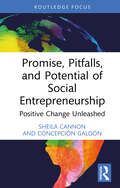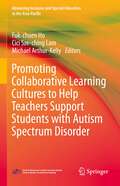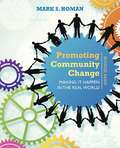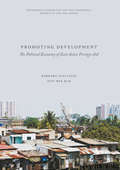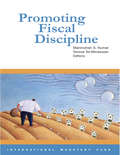- Table View
- List View
Prometheus: Infrastructure and Application Performance Monitoring
by Brian Brazil Julien PivottoGet up to speed with Prometheus, the metrics-based monitoring system used in production by tens of thousands of organizations. This updated second edition provides site reliability engineers, Kubernetes administrators, and software developers with a hands-on introduction to the most important aspects of Prometheus, including dashboarding and alerting, direct code instrumentation, and metric collection from third-party systems with exporters.Prometheus server maintainer Julien Pivotto and core developer Brian Brazil demonstrate how you can use Prometheus for application and infrastructure monitoring. This book guides you through Prometheus setup, the Node Exporter, and the Alertmanager, and then shows you how to use these tools for application and infrastructure monitoring. You'll understand why this open source system has continued to gain popularity in recent years.You will:Know where and how much instrumentation to apply to your application codeMonitor your infrastructure with Node Exporter and use new collectors for network system pressure metricsGet an introduction to Grafana, a popular tool for building dashboardsUse service discovery and the new HTTP SD monitoring system to provide different views of your machines and servicesUse Prometheus with Kubernetes and examine exporters you can use with containersDiscover Prom's new improvements and features, including trigonometry functionsLearn how Prometheus supports important security features including TLS and basic authentication
Promise to Pay: The Politics and Power of Money in Early America (American Beginnings, 1500-1900)
by Katie A. MooreAn incisive account of the crucial role money played in the formation and development of British North America. Promise to Pay follows America’s first paper money—the “bills of credit” of British North America—from its seventeenth-century origins as a means of war finance to its pivotal role in catalyzing the American Revolution. Katie A. Moore combs through treasury records, account books, and the bills themselves to tell a new story of money’s origins that challenges economic orthodoxy and mainstream histories. Promise to Pay shows how colonial governments imposed paper bills on settler communities through existing labor and kinship relations, their value secured by thousands of individual claims on the public purse—debts—and the state’s promise to take them back as payment for taxes owed. Born into a world of hierarchy and deference, early American money eroded old social ties and created new asymmetries of power, functioning simultaneously as a ticket to the world of goods, a lifeline for those on the margins, and a tool of imperial domination. Grounded in sustained engagement with scholarship from multiple disciplines, Promise to Pay breathes new life into old debates and offers an incisive account of the centrality of money in the politics and conflicts of empire, community, and everyday life.
Promise, Pitfalls, and Potential of Social Entrepreneurship: Positive Change Unleashed (Routledge COBS Focus on Responsible Business)
by Sheila Cannon Concepción GaldónThis book dives into the heart of social entrepreneurship as the authors share the latest research, global experiences, authentic private conversations, and diverse narratives around this widely popular concept. The idea and practice of social entrepreneurship has swept the world, taken up with enthusiasm by business leaders, nonprofit practitioners, and public policy makers alike. In this book, the authors argue that social entrepreneurship is surrounded by great promise, and that this high expectation has contributed to its pitfalls, setting it out as separate and different from other kinds of nonprofit organising, public service provision, and business for social benefit. After exploring the problem of inflated expectations, the authors rescue the concept from perfection – overly positive normative judgements – by presenting practical ways forward. The book sets out how to really unleash the power of social entrepreneurship so that it can actually deliver on its promise to improve how we organise for social purpose. This potential revolves around four key themes that are levers for social change: innovative individuals, social impact, scaling social enterprises, and the power of ecosystems. Through these themes, the book covers a wide range of approaches to social enterprise illustrated by specific examples and experiences from five continents. This accessible book is a valuable resource for a variety of practitioners, upper-level students, instructors, and business scholars, particularly those with an interest in social/environmental impact, entrepreneurship, business ethics, sustainable business, ESG and CSR.
Promises and Challenges of the Talent on Demand Model: Creating a New Paradigm
by Peter CappelliThe old paradigm of talent management has no place in the contemporary business environment, and so we must find a new one. We can start by recognizing that even the best forecasts are inaccurate over the long term. Other steps involve assessing outside hiring possibilities and dangers, changing how we think about developing talent internally, and finding new approaches to matching candidates with jobs.
Promising and Best Practices in Total Worker Health: Workshop Summary
by Victoria WeisfeldCombined with the more traditional employer occupational safety and health protection activities are newer employment-based programs to promote better health through helping workers quit smoking, lose weight, reduce stress, or exercise more regularly. In support of these efforts, some employers have made changes in their policies and facilities to support physical activity and healthier eating, and some employers connect with community resources for health education, health fairs, and other services. This diverse array of activities most typically has been planned, managed, and assessed - to the extent they exist in the workplace at all - by different, often uncoordinated departments within the business entity. Some employers have reconceptualized their safety, prevention, and promotion initiatives and attempted to bring them together into a coherent whole. The National Institute for Occupational Safety and Health (NIOSH) has supported this integration, defining Total Worker Health as "a strategy integrating occupational safety and health protection with health promotion to prevent worker injury and illness and to advance health and well-being. " In May 2014, with support from NIOSH, the Institute of Medicine organized a workshop on Total Worker Health. Rather than a review of published literature, this workshop sought input from a wide variety of on-the-ground stakeholders regarding their experiences with integrating occupational safety and health protection with health promotion in the workplace. Promising and Best Practices in Total Worker Health is the summary of the discussions and presentations of the event. This report identifies prevalent and best practices in programs that integrate occupational safety and health protection with health promotion in small, medium, and large workplaces; employer and employee associations; academia; government agencies; and other stakeholder groups.
Promontory, Inc.
by Amy Handlin Frank V. CespedesPromontory, Inc. is a small, privately-owned firm in the promotional products (specialty advertising) industry. After starting the firm two years ago with the intention of pursuing a high-quality/high-price strategy, the CEO is seeking methods of increasing sales revenues and profitability. He is considering whether and how to increase the size of the sales force, redirect, or redeploy the company's current sales efforts, utilize alternative marketing vehicles, and maximize sales potential. To attain this goal, the firm has bought some customization equipment and attempted to find niches in which it can succeed, by doing the work usually done by suppliers and manufacturers. The case raises numerous general marketing and sales management issues and provides a profile of various approaches to personal selling. At its heart is the appropriate marketing organization for this company's strategy, and especially, the details of execution in the field. These multipronged challenges make the case suitable for courses in Entrepreneurship, Marketing, Sales, Small Business Management, General Management, and Strategy.
Promote Your Inner Cowgirl: The Horse Lover’s Way to Work Less, Earn More, and Live Your Passion
by Lynda FlowersFor those who have denied their inner cowgirl for far too long, it is time to level up, jump back in the saddle, and return to life’s passion with Promote Your Inner Cowgirl.Lifelong cowgirl, entrepreneur, and nurse practitioner, Dr. Lynda Flowers has the answer. Throughout her life she’s had to balance the rigors of work and family with time to enjoy her love of horses. Now, after founding several startups, including her cowgirl coaching business, Dr. Flowers guides fellow horse lovers away from their frustration and toward the lifestyle they’ve always wanted. In Promote Your Inner Cowgirl, Dr. Flowers sets forth a framework to launch a business, generate income, and free up time to do what horse lovers love, along with how to:Set boundaries while aligning their goals and passionsStand out as a leader and team playerFind and launch a business that worksTurn past failures into future successesIdentify a team that is supportive
Promote Yourself: The new rules for building an outstanding career
by Dan SchawbelHow people perceive you at work has always been vital to a successful career. Now with the internet, social media, and the unrelenting hum of 24/7 business, the ability to brand and promote yourself is more crucial than ever.No matter how talented you are, it doesn't matter unless your bosses recognise those talents and think of you as an invaluable employee, a game-changing manager or the person whose name is synonymous with success.So, how do you stand out and get ahead?In Promote Yourself, Dan Schawbel lays out a step-by-step process for building a successful career through the subtle and amazingly effective art of self-promotion. By showing you how to build a rock-solid foundation of skill that are essential to getting the job done right and identifying exactly what managers value, Promote Yourself will provide you with the unique tools that you'll need today and for the rest of your career.
Promoters and Politicians: The North-Shore Railways in the History of Quebec 1854-85 (The Royal Society of Canada Special Publications)
by Brian YoungThe history of the north-shore railways provides a case study in the complexities of industrial development in nineteenth-century Quebec. Constructed in the fifteen years following Confederation, the North Shore and the Montreal Colonization Railways reinforced Quebec's integration into a transcontinental unit. Yet bankruptcy of both companies in 1875 forced the provincial government to assume ownership of the railways and to shoulder a financial burden that kept the province preoccupied, weak, and subservient to Ottawa. Diverse political, clerical, and business interests united to construct the railways and to manoeuvre them from private companies into a public venture and ultimately into the Canadian Pacific system.The two railways brought new concentrations of capital and power that cut across French and English ethnic lines and sharpened regional rivalries. Along the south short of the St. Lawrence both French- and English-speaking inhabitants protested against the province's commitments to its north-shore railways. By the late 1870s Quebec City's English community was lobbying hard against the growing power of their English-speaking counterparts in Montreal. The north-shore railways plagued a generation of Quebec politicians, and their construction bared incompatible regional aspirations. By 1885 years of negotiation, scandal, and political blackmail culminated in the incorporation of the two north-shore railways into the Canadian Pacific system. As this study so clearly demonstrates, Quebec paid a high price in making its contribution to linking Canada by steel a mari usque ad mare.
Promoting Balanced Competitiveness Strategies of Firms in Developing Countries
by Elias G. Carayannis Vivienne W WangSince the pioneering work of Joseph Schumpeter (1942), it has been assumed that innovations typically play a key role in firms' competitiveness. This assumption has been applied to firms in both developed and developing countries. However, the innovative capacities and business environments of firms in developing countries are fundamentally different from those in developed countries. It stands to reason that innovation and competitiveness models based on developed countries may not apply to developing countries. In this volume, Vivienne Wang and Elias G. Carayannis apply both theoretical approaches and empirical analysis to explore the dynamics of innovation in developing countries, with a particular emphasis on R&D in manufacturing firms. In so doing, they present an alternative to Michael Porter's Competitive Advantage Model--a Competitive Position Model that focuses on incremental and adaptive innovations that are more appropriate than radical innovations for developing countries. Their research addresses such questions as: Do innovations advance the competitive positions of manufacturing firms in developing countries? Does the pace of innovation matter, in particular, in socio-economic and socio-political contexts?To what degree can national innovation systems and policies influence development?To what extent do a firm's innovation commitments correlate with the protection of intellectual property rights?What roles do foreign direct investment and relationships with clusters and networks play?The resulting analysis not only challenges traditional theoretical approaches to innovation, but provides suggestions for improving business practice and policymaking.
Promoting Collaborative Learning Cultures to Help Teachers Support Students with Autism Spectrum Disorder (Advancing Inclusive and Special Education in the Asia-Pacific)
by Fuk-Chuen Ho Cici Sze-ching Lam Michael Arthur-KellyThis book goes through the changing pattern of various stages of teacher education development in Autism Spectrum Disorder, and then analyses the factors bearing on them. It presents a multifaceted approach in understanding the subject, as well as providing the current practice of teacher development for children with Autism Spectrum Disorder. This book suggests a system of professional development that builds on the principles of implementation science is most likely to lead to the adoption and use of innovations necessary to improve the quality of special education services. Implementation science emphasizes the systematic delivery of evidence-based practices. This book gives hints to educators and serves as a useful reference in the delivery of high quality professional development programmes.
Promoting Community Change: Making It Happen In The Real World
by Mark S. HomanDesigned for students who want to move beyond the theoretical discussion of community and become effective agents of change, PROMOTING COMMUNITY CHANGE, 6th Edition addresses the real-world issues facing professionals in social work, human services, and community health. <P><P>By emphasizing the role a strengthened community can play in preventing and solving the problems commonly experienced by individuals and families, the author gives students the tools they need to improve the lives of individual clients as well as entire communities. <P><P>Students will learn to identify the issues related to change so that they can bring clients, families, and other community members together to build a healthier community for themselves, their families, and their neighbors.
Promoting Competition in Innovation Through Merger Control in the ICT Sector: A Comparative and Interdisciplinary Study (Munich Studies on Innovation and Competition #10)
by Kalpana TyagiThis book addresses the question of how competition authorities assess mergers in the Information Communication Technology (ICT) sector so as to promote competition in innovation. A closer look at the question reveals that it is far more complex and difficult to answer for the ICT, telecommunications and multi-sided platform (MSP) economy than for more traditional sectors of the economy. This has led many scholars to re-think and question whether the current merger control framework is suitable for the ICT sector, which is often also referred to as the new economy. The book pursues an interdisciplinary approach combining insights from law, economics and corporate strategy. Further, it has a comparative dimension, as it discusses the practices of the US, the EU and, wherever relevant, of other competition authorities from around the globe. Considering that the research was conducted in the EU, the practices of the European Commission remain a key aspect of the content.Considering its normative dimension, the book concentrates on the substantive aspects of merger control. To facilitate a better understanding of the most important points, the book also offers a brief overview of the procedural aspects of merger control in the EU, the US and the UK, and discusses recent amendments to Austrian and German law regarding the notification threshold. Given its scope, the book offers an invaluable guide for competition law scholars, practitioners in the field, and competition authorities worldwide.
Promoting Creative Tourism: Proceedings of the 4th International Seminar on Tourism (ISOT 2020), November 4-5, 2020, Bandung, Indonesia
by A.H.G. KusumahThe papers presented in this work cover themes such as sustainable tourism; ICT and tourism; marine tourism; tourism and education; tourism, economics, and finance; tourism marketing; recreation and sport tourism; halal & sharia tourism; culture and indigenous tourism; destination management; tourism gastronomy; politic, social, and humanities in tourism; heritage tourism; medical & health tourism; film induced tourism; community based tourism; tourism planning and policy; meeting, incentive, convention, and exhibition; supply chain management; hospitality management; restaurant management and operation; safety and crisis management; corporate social responsibility (CSR); tourism geography; disruptive innovation in tourism; infrastructure and transportation in tourism development; urban and rural tourism planning and development; community resilience and social capital in tourism.The 4th ISOT 2020 aimed at (1) bringing together scientists, researchers, practitioners, professionals, and students in a scientific forum and (2) having discussions on theoretical and practical knowledge about current issues in tourism. The keynote speakers contributing to this conference are those with expertise in tourism, either in an academic or industrial context.
Promoting Development (Development Cooperation And Non-traditional Security In The Asia-pacific Ser.)
by Barbara Stallings Eun Mee KimThis book offers a new approach to studying foreign aid in the 21st century. While most analysts focus on the differences between traditional and emerging donors, Stallings and Kim here argue that a more important distinction is between East Asian donors and their western counterparts. Asian donors - Japan, South Korea, and China - cross the traditional and emerging divide and demonstrate a particular approach to development that draws on their own dramatic success. As East Asia continues its upward trajectory of economic development, the politics of aid can reveal surprising truths about the objectives and mechanisms of soft power and diplomacy in creating new networks in the region. This book will be of interest to NGO workers, scholars, and students of international relations, a critical part of research into Asia's rise and the emerging spheres of influence.
Promoting Equity and Justice Through Pedagogical Partnership (Series on Engaged Learning and Teaching)
by Alison Cook-Sather Elizabeth Marquis Alise de Bie Leslie LuqueñoFaculty and staff in higher education are looking for ways to address the deep inequity and systemic racism that pervade our colleges and universities. Pedagogical partnership can be a powerful tool to enhance equity, inclusion, and justice in our classrooms and curricula. These partnerships create opportunities for students from underrepresented and equity-seeking groups to collaborate with faculty and staff to revise and reinvent pedagogies, assessments, and course designs, positioning equity and justice as core educational aims. When students have a seat at the table, previously unheard voices are amplified, and diversity and difference introduce essential perspectives that are too often overlooked.In particular, the book contributes to the literature on pedagogical partnership and equity in education by integrating theory, synthesizing research, and providing concrete examples of the ways partnership can contribute to more equitable educational systems. At the same time, the authors acknowledge that partnership can only realize its full potential to redress harms and promote equity and justice when thoughtfully enacted. This book is a resource that will inspire and challenge a wide variety of higher education faculty and staff and contribute to advancing both practice and research on the potential of student-faculty pedagogical partnerships. Presenting a conceptual framework for understanding the various epistemological, affective, and ontological harms that face students from equity-seeking groups in postsecondary education, Promoting Equity and Justice Through Pedagogical Partnership applies this conceptual framework to current literature in partnerships, highlighting the promise of partnership as the way to redress these harms. The authors ground both the conceptual framework and the literature review by offering two case studies of pedagogical partnership in practice. They then explore the complexities raised by their framework, including the conditions under which partnerships themselves may risk reproducing epistemic, affective, or ontological harms. Applying the framework in this way allows them to propose strategies that make it more likely for these mediations to be successful. Finally, the authors focus on the future of pedagogical partnership and share their perspectives on new directions for inquiry and practice. After summarizing the overarching themes developed throughout the book, the authors leave the reader with a set of questions and recommendations for further inquiry and discussion. Visit the Promoting Equity and Justice through Pedagogical Partnership Companion page, hosted by the Center for Engaged Learning.
Promoting Fashion
by Barbara Graham Caline AnoutiThe marketing and promotion of fashion is entering a fast-moving and challenging phase. This book shows how to appeal to the consumer and communicate the brand message. Advertising campaigns, both offline and online, are discussed, together with the existing and new methods of PR and promotion. Individual chapters then look at social media, e-commerce and online fashion retail, personal selling and offline fashion retail, direct marketing, fashion shows and sales promotions, plus costing a campaign. These are supported by case studies and interviews with leading professionals.
Promoting Fashion
by Barbara Graham Caline AnoutiThe marketing and promotion of fashion is entering a fast-moving and challenging phase. This book shows how to appeal to the consumer and communicate the brand message. Advertising campaigns, both offline and online, are discussed, together with the existing and new methods of PR and promotion. Individual chapters then look at social media, e-commerce and online fashion retail, personal selling and offline fashion retail, direct marketing, fashion shows and sales promotions, plus costing a campaign. These are supported by case studies and interviews with leading professionals.
Promoting Fiscal Discipline
by International Monetary FundFiscal discipline is essential to improve and sustain economic performance, maintain macroeconomic stability, and reduce vulnerabilities. Discipline is especially important if countries, industrial as well as developing, are to successfully meet the challenges, and reap the benefits, of economic and financial globalisation. Lack of fiscal discipline generally stems from the injudicious use of policy discretion. The benefits of discretion are seen in terms of the ability of policymakers to respond to unexpected shocks, and in allowing elected political representatives to fulfill their mandates. But discretion can be misused, resulting in persistent deficits and procyclical policies, rising debt levels, and, over time, a loss in policy credibility. The authors first explore the role of discretion in fiscal policy, and the extent, consequences, and causes of procyclicality, particularly in good times. They then examine how a variety of institutional approaches - fiscal rules, fiscal responsibility laws, and fiscal agencies - can help improve fiscal discipline. While each of these approaches can play a useful role, the authors suggest that a strategy combining them is likely to be particularly beneficial. Although such a strategy requires political commitment and effective fiscal management, at the same time, the strategy itself can bolster political commitment by highlighting the restraints on government and raising the costs of failing to respect them.
Promoting Good Governance, Development and Accountability
by Susan Brown-ShafiiIn addressing the politics of the international regulation of public procurement, this book fills a major gap in the literature. Brown-Shafii does this by investigating whether a WTO Agreement can be used to promote good governance, development and accountability.
Promoting Growth in Sub-Saharan Africa
by Anupam Basu Dhaneshwar Ghura Evangelos A. CalamitsisA report from the International Monetary Fund.
Promoting Health Equity Among Racially and Ethnically Diverse Adolescents: A Practical Guide
by Lisa Barkley Maria Veronica Svetaz Veenod L. ChulaniRacial and ethnic minority youth have less access to health care and experience health disparities that are linked to social determinants that impact their health and well-being. This book is a practical reference for clinicians caring for racially and ethnically diverse adolescents seeking to effectively identify and address the social structures and factors that influence their health and well-being to promote health equity. It provides an overview of key health equity, population health and cultural competency principles and highlights clinical, teaching, and research skills critical to promoting health equity. Clinically oriented chapters provide guidance on strength-based approaches and strategies that clinicians can integrate in their encounters with diverse youth and feature clinical vignettes, clinical pearls and reflection questions to promote the application of concepts to practice. Promoting Health Equity Among Racially and Ethnically Diverse Adolescents is a valuable resource for clinicians across all areas of medicine.
Promoting Inclusive Classroom Dynamics in Higher Education: A Research-Based Pedagogical Guide for Faculty
by Kathryn C. OlesonThis powerful, practical resource helps faculty create an inclusive dynamic in their classrooms, so that all students are set up to succeed. Grounded in research and theory (including educational psychology, scholarship of teaching and learning, intergroup dialogue, and social justice theory), this book provides practical solutions to help faculty create an inclusive learning environment in which all students can thrive. Each chapter focuses on palpable ideas and adaptive strategies to use right away when teaching. The first chapter consider professors’ intersecting personal and social identities and their expectations for themselves and their students. Chapter 2 considers students’ backgrounds, including class, race, disability, and gender, and focuses on what students bring to the classroom, exploring their basic psychological needs of autonomy, competence, and belonging; their approaches to learning; and their self-doubts and uncertainties. Chapter 3 draws on universally-designed learning in combination with educational design rooted in social justice and multiculturalism to describe ways to design spaces in which students flourish academically. Two chapters focus on classroom dynamics. Chapter 4 primarily focuses on preparation for having difficult conversations in the classroom, considering how instructors can create a shared understanding between themselves and their students. Chapter 5 focuses on in-the-moment strategies to both create and manage discomfort about sensitive and controversial topics while supporting students of various social identities (such as gender, race, disability). In the closing chapter, the author integrates all the elements in the preceding chapters, and also presents more general college-wide programs to help faculty develop and improve their teaching.
Promoting Information in the Marketplace for Financial Services
by Paul Latimer Philipp MaumeThis book provides a unique comparative and global analysis of the regulation of disclosure in financial (securities) markets. It is written by two authors who represent both the new world (Australia) and the old world (Germany). The authors present their research in the global business context, with legal and regulatory perspectives including some references from Africa, Asia, the Middle East and South America. After every "boom" and "bust", legislators pass new disclosure legislation, often in a heated environment fuelled by politics and the media. Little regard is paid to existing regulation or the lessons learned from earlier regulation. The result is the continuing enactment of redundant and overlapping disclosure laws. Since financial markets are often described as markets for information, the failure to ensure disclosure is at the heart of financial services regulation. This book argues that the solution to the failure of disclosure is a brief, easily understood, principles-based, plain English safety-net amendment to statute law such as "you must keep the financial market fully informed", a measure that would support effective mandatory continuous disclosure of information to financial markets. This book examines the reasons for disclosure regulation, and how the efficient operation of financial markets is dependent on disclosure. It examines the adequacy of common law and civil law concerning broker/client disclosure, and concludes that industry licensing in itself fails to keep the market informed. While recognizing the failures of securities commissions to achieve good disclosure in financial markets, it confirms the effectiveness of coregulation of disclosure by a commission with the support of the financial markets (such as the stock exchange). Coregulation builds on financial market self-regulation, and is best described in the words of one-time SEC Chairman William O. Douglas, who, in the 1930s, described it as a shotgun behind the door.
Promoting Innovation, Productivity and Industrial Growth and Reducing Poverty
by Maureen Mackintosh, Joanna Chataway and Marc WuytsDevelopment and the ending of mass poverty require a massive increase in productive capabilities and production in developing countries. Some countries, notably in Asia, are achieving this. Yet ‘pro-poor’ aid policies, especially for the least developed countries, operate largely without reference to policy thinking on the promotion of innovation for productivity growth. Conversely, policy-makers and researchers on innovation and industrial policies tend to know little about the potential for social protection to support innovation and productivity improvement. This book aims to focus attention on this gulf between research on innovation and on poverty reduction and to identify some of its policy consequences; to set out some ways in which this gulf can be bridged, analytically and empirically; and to contribute to the creation of an agenda for further research and an understanding of the urgency of the implied rethinking. The first two chapters provide sustained arguments for embedding social policy thinking in much more ‘productivist’ frameworks of thought that focus on raising productivity and employment; and for identifying growth theories that can incorporate satisfactory understandings of innovation and employment upgrading. A set of chapters then tackle these broad themes in the context of health, addressing the interlinked issues of innovation, health inequity and associated impoverishment. The final set of chapters examines the challenge of creating industrial policies that generate both innovation and employment, using and going beyond concepts of systems of innovation.


